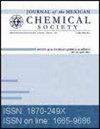Phytochemical Profile, Antioxidant and Antibacterial Activities of Artemisia absinthium L. Collected from Tunisian Regions
IF 0.8
4区 化学
Q3 CHEMISTRY, MULTIDISCIPLINARY
引用次数: 1
Abstract
Abstract. The aim of this comparative research was to determine the chemical composition, antioxidant and antibacterial activities of the methanolic extracts and essential oils (EOs) of Artemisia absinthium aerial parts from five different regions (Bizerte, Zaghouan, Kasserine, Gabes and Tozeur). The polyphenol and flavonoid contents significantly varied (P < 0.05) among the studied regions with maximal contents observed in Zaghouan. Based on the High Performance Liquid Chromatography results, quercetin and isorhamnetin were the main compounds and their percentages were region dependent. The methanolic extract of Zaghouan showed the highest scavenging ability of DPPH (IC50 = 31.46 ± 1.42 µg/mL). A. absinthium EOs from of the different regions were found to interestingly inhibit the growth of both Gram-negative and Gram-positive bacteria strains. The antibacterial effect was strongly related to the organoleptic EO quality. The EO of Zaghouan exhibited an important inhibitory effect with an inhibition zone estimated at 31 mm against Escherichia coli strain. The EO composition was obtained by GC-MS analysis showing the presence of thirty-five compounds. Camphor (49.70 ± 2.34 %) and chamazulene (25.41 ± 0.61 %) were the main constituents. These results suggested that the north regions have a high potential for selecting varieties rich on bioactive volatile and phenolic compounds. Resumen. El objetivo de esta investigación fue determinar y comparar la composición química, las actividades antioxidantes y antibacterianas de los extractos metanólicos y de los aceites esenciales (AE) de las partes aéreas de Artemisia absinthium de cinco regiones (Bizerta, Zaghouan, Kasserine, Gabes y Tozeur). Los contenidos de polifenoles y flavonoides variaron significativamente (P < 0,05) entre las regiones estudiadas con contenidos máximos observados en Zaghouan. De acuerdo con los resultados de la cromatografía líquida de alta resolución, la quercetina y la isorhamnetina fueron los compuestos principales y sus porcentajes dependieron de la región. El extracto metanólico de Zaghouan mostró la mayor capacidad secuestrante de DPPH (IC50 = 31.46 ± 1.42 µg mL-1). Se descubrió que los aceites esenciales de A. absinthium de las diferentes regiones inhibían de manera interesante el crecimiento de cepas de bacterias Gram-negativas y Gram-positivas. El efecto antibacteriano estuvo fuertemente relacionado con la calidad organoléptica del AE. El AE de Zaghouan exhibió un importante efecto inhibidor con un halo de inhibición estimado en 31 mm frente a una cepa de Escherichia coli. La composición de AE se obtuvo mediante análisis GC-MS y mostró la presencia de treinta y cinco compuestos. El alcanfor (49.70 ± 2.34 %) y el camazuleno (25.41 ± 0.61 %) fueron los principales constituyentes. Estos resultados sugirieron que las regiones del norte tienen un alto potencial para seleccionar variedades ricas en compuestos bioactivos volátiles y fenólicos.突尼斯地区苦艾草的植物化学特征及其抗氧化和抗菌活性
摘要本研究旨在比较五个不同产地(比塞尔特、扎古万、卡塞林、加贝斯和托泽尔)苦艾的甲醇提取物和挥发油的化学成分、抗氧化和抗菌活性。多酚和黄酮类化合物含量在不同区域间差异显著(P < 0.05),以扎宽区含量最高。高效液相色谱分析结果表明,槲皮素和异鼠李素为主要成分,其含量呈区域依赖性。Zaghouan甲醇提取物对DPPH的清除能力最高(IC50 = 31.46±1.42µg/mL)。来自不同地区的苦艾草精油对革兰氏阴性和革兰氏阳性菌株的生长均有抑制作用。抗菌效果与其感官质量密切相关。Zaghouan的EO对大肠杆菌有明显的抑制作用,抑制区约为31 mm。通过气相色谱-质谱分析得到其EO组成,共含有35个化合物。主要成分为樟脑(49.70±2.34%)和chamazulene(25.41±0.61%)。这些结果表明,北方地区具有丰富的生物活性挥发物和酚类化合物品种选择潜力。Resumen。El objtivo de esta investigación燃料测定比较la composición química, las活性抗氧化剂的抗氧化剂的提取物中含有的芦荟提取物metanólicos与芦荟提取物中含有的芦荟提取物(AE)的提取物中含有的芦荟提取物中含有的抗氧化剂的活性(比塞塔,扎格万,卡塞林,加贝斯和托泽尔)。黄芪多酚类黄酮含量差异显著(P < 0.05),不同地区黄芪多酚类黄酮含量差异显著(P < 0.05)。De acuerdo con los resultados De la cromatografía líquida De alta resolución, la querticina De isorhamnetina fueron De compuestos principales as porcentajes dependererde la región。El extracto metanólico de Zaghouan mostró la mayor capacidad secuestrante de DPPH (IC50 = 31.46±1.42µg mL-1)。descubrió不同地区苦艾草菌的菌群特征inhibían革兰氏阴性菌群特征与革兰氏阳性菌群特征。抗细菌剂的研究进展及其与有机化学化学的关系。El AE de Zaghouan exhibió对抑菌剂对大肠杆菌的抑制作用不显著inhibición估计在31 mm范围内对大肠杆菌有影响。La composición de AE se obtuvo mediante análisis GC-MS y mostró La presence de treinta y cinco compuestos。El alcanfor(49.70±2.34%)和El camazuleno(25.41±0.61%)fueron los principales constituyentes。研究结果表明,在不同的区域中,研究人员发现了潜在的生物选择性变化,如计算机生物活性volátiles和fenólicos。
本文章由计算机程序翻译,如有差异,请以英文原文为准。
求助全文
约1分钟内获得全文
求助全文
来源期刊
CiteScore
2.00
自引率
0.00%
发文量
0
审稿时长
6-12 weeks
期刊介绍:
The Journal of the Mexican Chemical Society (J. Mex. Chem. Soc.) is a scientific, blind, peer reviewed, and open access, free of charge publication that covers all areas of chemistry and its sub-disciplines (i.e. medicinal chemistry, natural products, electrochemistry, material science, computational chemistry, organic chemistry, bionirganic chemistry, etc). It is devoted to facilitating the worldwide advancement of our understanding of chemistry. It will primarily publish original contributions of research in all branches of the theory and practice of chemistry in its broadest context as well as critical reviews in active areas of chemical research where the author has published significant contribution. The J. Mex. Chem. Soc. is a quarterly publication which language of submission and publication is English. To be suitable for publication in J. Mex. Chem. Soc., manuscripts must describe novel aspects of chemistry, high quality of results and discussion an excellent bibliographic support, and contribute to the development of the field. Routine or incremental work are not suitable for publication in J. Mex. Chem. Soc. Authors are encouraged to send contributions in electronic form. Our online submission system guides you stepwise through the process of entering your article details and uploading your files.

 求助内容:
求助内容: 应助结果提醒方式:
应助结果提醒方式:


